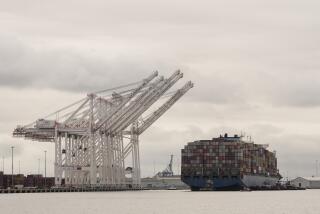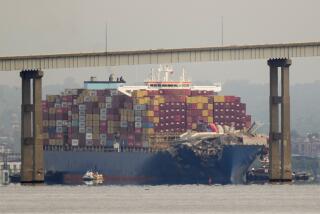TRANSPORTATION : Seattle Has That Sinking Feeling : Loss of bridges reminds area that it commutes on a thin, perilous ribbon.
SEATTLE â The sinking of a landmark floating bridge served as a costly and unsettling reminder that the ever-proud, water-loving city of Seattle exists at the end of a thin and perilous ribbon of transportation.
The Thanksgiving weekend loss of great chunks of the 1.5-mile-long Mercer Island Floating Bridge also delivered an embarrassing black eye. Here, where modern engineering reaches a zenith in production of the mighty Boeing jet airplanes, three major bridges have dropped into deep, cold waters in the last 50 years, two of them floating bridges.
In this water-bound region, driving over bridges, as the old wheeze goes, is like breathing. You donât miss it until you canât.
Right now, and for months and maybe years to come, the already heavily congested Seattle metropolitan region will suffer from the loss of this 50-year-old bridge and the damage its plunge to the bottom did to an adjacent and parallel floating bridge, the seven-lane I-90 bridge.
BACKGROUND: The two bridges spanned the long, narrow freshwater Lake Washington, which separates Seattle and its eastern suburbs.
The I-90 bridge was completed in 1989. The Mercer Island bridge was then closed for a $37-million renovation and was supposed to be reopened in 1992 to help reduce congestion and hourlong commutes in this booming region.
When the old bridge suddenly gurgled, heaved over on its side and sank, span by span, into the 200-foot-deep lake on the Sunday after Thanksgiving, it descended upon and damaged anchor cables that held the newer I-90 bridge steady.
Ever since, a fleet of tugboats, a large salvage ship and barges laying 11-ton anchors have been deployed to stabilize the newer bridge. This has created a commuter nightmare: I-90 is sometimes open, sometimes closed, sometimes open only one way. And every storm reawakens fears that the new bridge also will pull loose from its moorings before anchor cables can be replaced.
That would leave only one bridge--a smaller floating structure several miles to the north--on which commuters could cross Lake Washington.
Some structural disasters defy explanation, but the cause of the bridge collapse now being suggested is so straightforward and simple as to be embarrassing: It happened when the hollow, boat-like hull beneath the roadway filled with water during storms over the Thanksgiving holiday.
There were uncovered openings in the top and along the sides of the bridge--the oldest major floating bridge in the world--and water rushed in, apparently cracking the hull. As more water rushed in, the bridge lost its buoyancy and sank.
âIt seems absurd,â state transportation official Ron Anderson told reporters.
It does, particularly because only 11 years ago another regionally famous floating bridge broke up and sank in heavy weather. That was the 1.3-mile Hood Canal Bridge, an important link between the Puget Sound area and the Olympic Peninsula.
Bridge troubles here go beyond floating bridges. In 1940, south of Seattle, the third-longest suspension bridge in America--the Tacoma Narrows Bridge, known as âgalloping Gertieâ--rolled and twisted in a storm and collapsed into Puget Sound.
IMPACT: Today, all kinds of experts are busy wagging the finger of blame and saying, âI told you so,â about the latest disaster.
Meanwhile, Seattle, although sometimes quick to pull up its hospitality bridge and discourage Californians and other would-be immigrants from moving here, is counting on the rest of the country to pay the bulk of replacement costs of a new Mercer Island Floating Bridge.
Already, politicians here have been pleased to report home that up to $100 million in federal funds is available to assist in the reconstruction.
More to Read
Sign up for Essential California
The most important California stories and recommendations in your inbox every morning.
You may occasionally receive promotional content from the Los Angeles Times.










